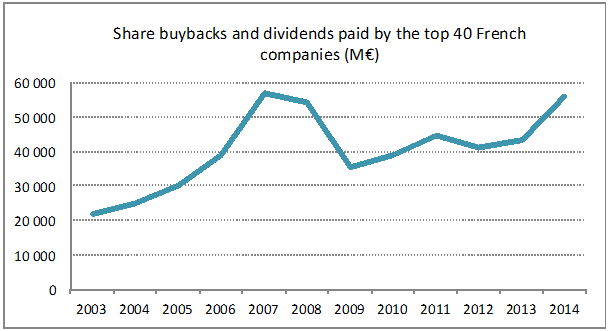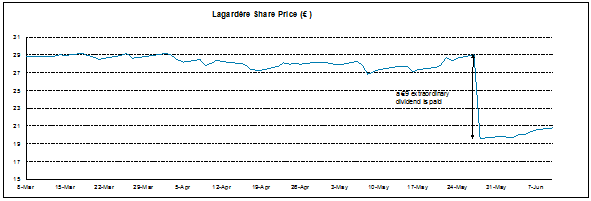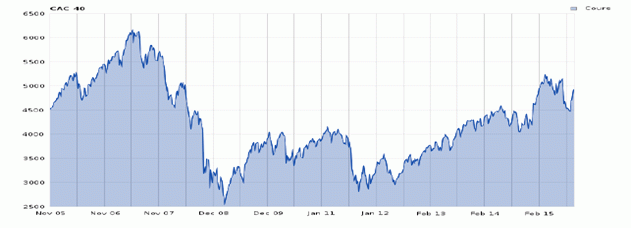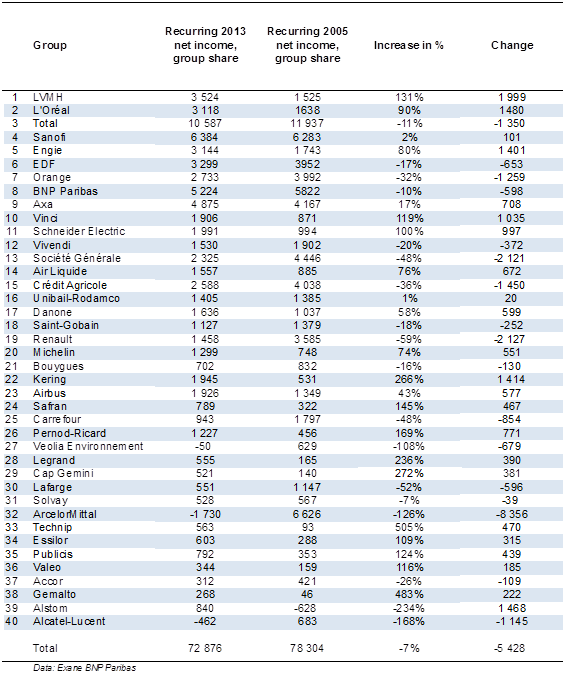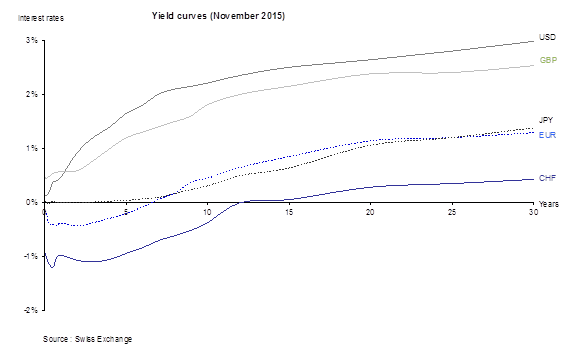Letter number 91 of December 2015
- TOPIC
- STATISTICS
- RESEARCH
- QUESTIONS & COMMENTS
News : Does paying dividends make shareholders wealthier?
Philippe Martinez, General Secretary of the French CGT trade union, does us the honour of using data published in the Vernimmen Newsletter in his interview with the Journal du Dimanche on 25 October: “He (François Hollande) has said that finance is his enemy, but dividends have increased by 60% over the last five years (...)".
Le Monde newspaper took the trouble to check Philippe Martinez’ figures and noted that the French edition of Vernimmen Newsletter, in its annual publication of the amount of share buybacks and dividend payments, put them at €56bn in 2014 compared with €35bn in 2009, which is an increase of 60%.
We’ll gloss over the fact that if, instead of choosing 2009, Philippe Martinez had taken 2008, the increase would only have been 3%, or -2% with a basis for comparison in 2007. Though of course, a trade unionist is not expected to have the same intellectual rigour as a researcher.
No, the real issue is the frequently made mistake of assimilating the payment of dividends and the enrichment of shareholders. Nothing could be further from the truth.
There are three ways of looking at it:
Based on absurd reasoning: If shareholders are made richer by receiving dividends, then they should be made poorer when they don’t receive them. And the shareholders of Google or Critéo, groups that have never paid a dividend, would have a lot to complain about. However, their share prices have gone up by 1 570% and 17% respectively since they were listed (in 2004 and 2013) and the value of their equity capital has increased to fivefold their net book value contributed by shareholders. Not exactly what we'd call an impoverishment of shareholders!
Based on observation: When a company pays a dividend to its shareholders, the value of its shares automatically falls by as much, as illustrated by the extraordinary dividend paid by Lagardère in 2014:
For small dividends, a magnifying glass may be needed to see the drop in the share price which may be concealed by daily share price variations. But it is very real.
Based on reasoning: In fact, a company that pays a dividend is disposing of one of its assets (cash). So it’s only logical that the value of its equity should fall by as much, since the company as an entity has become poorer as a result of the payment to its shareholders of part of its cash in the form of dividends.
In other words, at the same time as a money transfer representing the dividend is paid into the shareholder’s bank account, which makes him/her richer, the shareholder gets poorer by the same amount as a result of the drop in the value of his/her shares. So all in all, in terms of value, the dividend is neutral for shareholders, which is only logical since the company in whose capital they hold a stake transfers part of its cash to them. It’s just transferring wealth from the left pocket to the right. There is no enrichment possible or any net remuneration as a result of this fact.
This is where fundamentally dividends differ from wages, which Marxist vulgate wrongly holds to be equivalent. Fortunately for us as employees, whenever our monthly salaries are transferred, we don’t lose the same amount elsewhere!
If the dividend doesn’t enrich the shareholder, then who or what does it enrich?
Net earnings.
On this basis, we looked at the progression of earnings of the CAC 40 (the top 40 listed French groups) between 2005 and 2013. Why 2005? Because this is a year that is far enough back now (we must let time pass), half-way between the lows of 2002 and 2003 and the highs of 2007 and 2008. Why 2013? Because this is the last year we have analysed in terms of profits, which gave rise to a dividend in 2014, the last completed year to date.
In 2005, the members of the CAC 40 recorded accumulated net earnings of €78.3bn.
In 2013, the members of the CAC 40 recorded accumulated net earnings of €72.9bn, which is a fall-off of 7%.
And let’s not forget that by construction, CAC 40 companies are, with a few exceptions, the best performing companies in France. So what can we say about other French companies?
And investors are not mistaken, the same investors that today value the CAC 40 at its 2005 level:
Apart from some stellar performances (+100% for Schneider Electric, +131% for LVMH, +483% for Gemalto), we have also seen some spectacular collapses (-48% for Société Générale, -52% for Lafarge, -59% for Renault). ArcelorMittal’s net earnings fell from €6.6bn to a negative €1.7bn. Even if we take it out of the sample, the increase in the net earnings of the CAC 39 is only 4% over 8 years.
We won’t be so facetious as to point out to Mr. Martinez, that comparing what is comparable, i.e. the enrichment of some (wages) with the enrichment of others (net earnings), that the decline in the CAC 40's net earnings is compared with an increase in wages over this period. The opposition of capital and labour is one of those dogmas that fortunately has fallen by the wayside, as is shown by the top performing companies on a daily basis.
Finally, let’s remember that a good dividends policy is judged on the basis of the marginal rate of return on investments[1] and that if a company has no more profitable investment opportunities, it makes no sense investing just for the sake of it. This would be a waste of a rare commodity, money, which could be put to much better use elsewhere, in other companies or in other sectors, for example in innovation or future growth, as we are reminded by new start-ups which are created every day. It is better to pay out this surplus cash, as Google has now understood – it has announced an inaugural share buyback for $5bn.
So, neither a totem nor a taboo, the dividend is one of the healthy ways that capital is reallocated, via the financial system, within the economy, from those who no longer need it to those who need it.
Statistics : Interest rate curves around the world
12 years. That’s the maturity period for the first Swiss government loan with a positive interest rate. For other shorter periods, there are only negative interest rates. For Germany, this period is 7 years, its 6 years for France and 3 years for Italy or Spain.
0.45 %. That’s the cost of 10-year debt for Germany and about what a 30-year loan would earn for you in Switzerland. The figure is 1.78% for France at 30 years, compared with 2.5% in the UK and 3% in the USA. So there are some good things in the euro zone.
There is an impression that the interest rate curves are sloping, but when you look at the scale from a completely different point of view, even if it’s a view that has never been seen before! So investors aren’t expecting a very large increase in interest rates very soon.
Research : Company mergers: their consequences in terms of the price and quality of products sold
With Simon Gueguen – Lecturer-researcher at the University of Paris Dauphine
A lot has been written about the consequences of mergers and acquisitions on the value of firms. Most studies show that the combined impact for the acquirer and the target is positive. The market reacts positively to the announcement of the merger and operating performance improves over the medium- and long-term (profits increase). The debate most often covers the way gains are divided up among the different parties involved in the operation[1]. Another issue that is worth looking at remains largely unexplored: identifying the source of this creation of value. A recently published article[2] sheds some light on the matter. Such operations result in an improvement in the quality-price ratio of products sold.
The difficulty of identifying the impact of mergers on the price and quality of products comes from the diversity of brands and products sold by merged companies. An observation of accounting data (aggregated) does not enable us to measure this impact accurately. Additionally, the merger may occur at the same time as a development in the sector in question (technological progress for example), in which case the improvement in the quality-price ratio would not be the consequence of the merger itself. In order to overcome these methodological difficulties, the author of the article presented here looked into the information published in the US monthly magazine Consumer Reports. This magazine publishes the results of tests carried out by independent experts on the quality of products. It has the advantage of applying a testing and rating methodology that is stable over time, and of covering a large number of products (over 9,000 branded products over the period of the study, between 1980 and 2009). This made it possible to study the consequences of a merger at the level of the product lines. Sheen also relies on Consumer Reports for the identification of substitutable products as the magazine classifies the products tested into 20 categories. He uses an econometric technique called consistent difference-in-difference, which in this case involves measuring the difference between on the one hand, the development of products concerned by the merger and on the other hand, the general development of products in the same category at the same time. Using this technique, it is possible to assess the impact of the event being studied (the merger) by distinguishing trends that affect the whole sector.
With regard to mergers, which are at the heart of the article, Sheen shows that the products of the acquirer and the target converge in quality, while their prices decline compared with the prices of competitive products. These results support the idea that the merger results in synergies and economies of scale, but also that part of the synergies is passed on to consumers. The convergence of quality and the fall in prices take place gradually over a period of two to three years following the merger. An interesting result, that tends to confirm the synergies assumptions, is that the effects observed disappear when the merger is between companies that do not offer competitive products. Synergies are higher in mature sectors with low growth, which needs a greater improvement in the quality-price ratio in order to attract consumers.
Moreover, Sheen uses this original data base to carry out a certain number of tests which are not the point of the article but the results of which are worth mentioning. Accordingly, the products of the largest companies are of a better quality and have a lower price (the direction of the causality here is uncertain - the ability to provide competitive products is perhaps the reason why they have become large companies). On the other hand, when the same company offers the same type of product under different brands, there is a bigger difference in the price of the products than in their quality. This suggests a strategy of segmentation though prices.
The main interest of the article is the identification of a possible source of value creation when companies merge – the increase in the quality-price ratio of products sold. If other studies confirm the effects identified on other samples, this would mean that mergers (in general) create value not only for the acquirers’ shareholders, and even those of the target, but also for their customers.
[1] See further in the article “Do mergers and acquisitions create value?” in Vernimmen Newsletter.com 79 December 2013 and chapter 44 of the Vernimmen.
[2] A. SHEEN (2014), “The real product market impact of mergers”, Journal of Finance, vol. 69-6, pages 2651 à 2688.
Q&A : Should listed companies be forced to adopt a code of corporate governance?
In most countries, there is no obligation to adopt a code of corporate governance. A listed company that decides not to comply with a code is often required to explain, in its annual report, the reasons why it has made this choice. This is the principle of “apply or explain”.
It’s difficult for us to imagine today that a company which lists its shares on the stock exchange could operate without independent directors on its board, or, except for the very smallest among them, without having adopted a code of corporate governance. In fact, listing is like wanting to join a club the rules of which you have to accept, or else you don’t join it. There is a very simple and efficient way for investors to sanction a company that wants to list its shares without having any independent directors and without implementing a code of corporate governance and that is by refusing to buy its shares.
For companies that are already listed, this penalty is a double-edged sword, as it naturally penalises investors through the drop in share prices that it causes. Majority shareholders which do not pay much attention to corporate governance could in fact take advantage of these low prices to organise the delisting of the company, by expropriating the minority shareholders in woeful financial conditions.
In our view, it would make sense, 20 years after the appearance of the first recommendations and corporate governance codes, to move on from “apply or explain” to “apply or leave” in this area. Companies could be given a period of one or two years to open up their Boards to independent directors and to adopt a code of corporate governance. Failing this, they should be required to delist in normal conditions for expropriations.
Either a company wants to be listed on the stock exchange and then it must comply with the rules that apply to companies of all sizes that list their shares on the stock exchange or a company declines to comply with the rules by refusing to have independent directors and refusing to adopt a code of corporate governance. In this case, the company should be consistent and delist. Given that there is or soon there will be a minimum quota of women directors in most countries, imposing the adoption of a code of corporate governance, and hence the presence of independent directors on the boards of listed companies, seems to us to go without saying.
